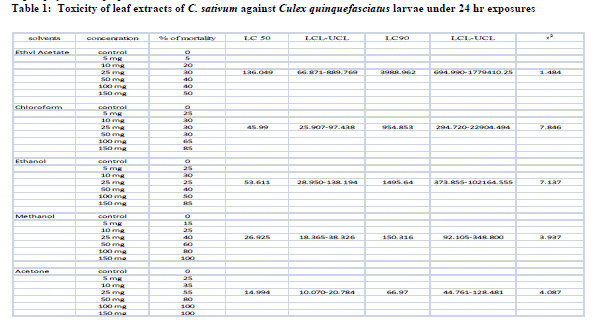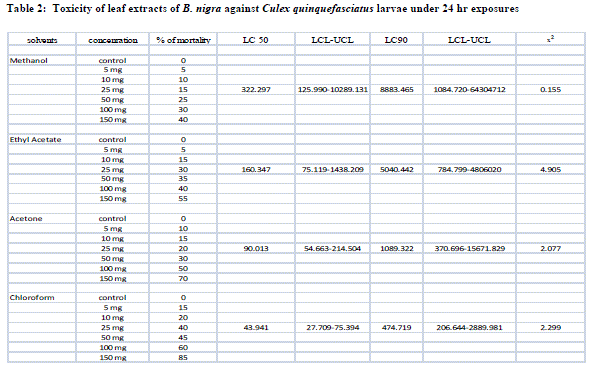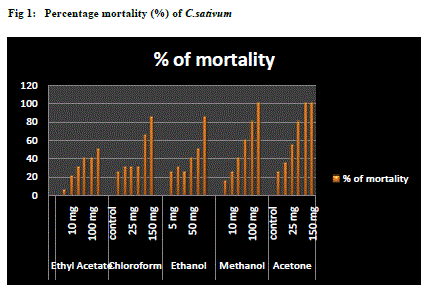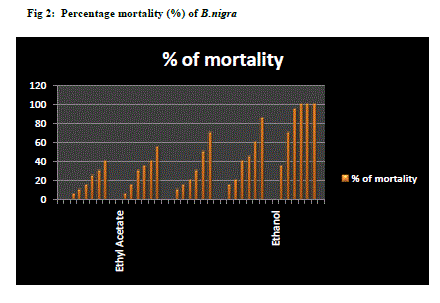ISSN ONLINE(2319-8753)PRINT(2347-6710)
ISSN ONLINE(2319-8753)PRINT(2347-6710)
Deepika Thangaraj1, Ramanibai Ravichandran2 and Madhavarani Alwarsamy3
|
| Related article at Pubmed, Scholar Google |
Visit for more related articles at International Journal of Innovative Research in Science, Engineering and Technology
To determine the larvicidal activity of different solvent of seed extracts of Coriandrum sativum (C.sativum) and Brassica nigra (B.nigra) against filariasis vector Culex quinquefasciatus (C.quinquefasciatus). Larvicidal efficacy of the crude seed extracts of Coriandrum sativum and Brassica nigra with five different solvents like acetone, ethyl acetate, methanol, ethanol and chloroform was tested against the mosquito larvae of C.quinquefasciatus. The mortality was observed after 24 h under laboratory conditions. Among the tested solvents the maximum efficacy was observed in the acetone extract and methanol extract. The LC50 and LC90 values of C.sativum were found to be 14.994 and 66.970 and B.nigra was found to be 322.297 and 8883.465. The Chi-square values were significant at P<0.05 level. From the investigations it was concluded that the crude extract of Coriandrum sativum and Brassica nigra showed an excellent potential for controlling the larval instars of C.quinquefasciatus.
Keywords |
| Culex quinquefasciatus, Larvicidal activity, Seed extracts, Probit analysis |
INTRODUCTION |
| Many parts of India, especially cities harbor large number of mosquitoes. The dusk starts with the entry of mosquitoes enmass. Mosquitoes are carriers of a number of diseases such as malaria, dengue fever, yellow fever, rift valley fever, filariasis, ect,. They are responsible for the death and illness of millions of people and animals through the transmission of diseases [1]. Most people consider mosquitoes as an annoyance; there tiny assassins have the potential and lethal capacity to kill more than a million victims a year around the world[2]. There are about 90 genera and 2500 species of mosquitoes all over the world. Only female mosquitoes suck blood of man/animals while males feed on the nectar and juice of the flowers. All mosquitoes show amphibious nature during their life time. Female mosquitoes inject saliva into the host before sucking blood. The saliva into the host before sucking blood. The saliva may contain viruses, bacteria, protozoa etc., which cause diseases in the body. Thus diseases are transmitted from one man to another through mosquitoes. |
| Control measures used against mosquitoes include elimination of breeding sites, application of surface films of oil to clog the breathing tubes of wrigglers and the use of larvicides. Many strains of the mosquito are resistant to conventional insecticides, hence, people of Mahe use mosquito coils, mats and other chemicals to repel mosquitoes [3]. There are many serious drawbacks in the use of synthetic insecticides for vector control. This factor created the need for environmentally safe, degradable and target specific insecticides against mosquitoes. Safer and non-selective extracts from plants are used to control insects since ancient times. More than 2000 species are reported to have insecticidal properties. Synthetic insecticides create a number of ecological problems, such as the development of resistance insect strains, ecological imbalance and harm to mammals. Natural products are generally preferred because of their less harmful nature to non-target organisms and due to their innate biodegradability[4]. The continuous application of the organophosphates such as temephos and fenthion and insect growth regulators such as diflubengeron and methoprene, are generally used for the control of mosquito larvae[5]. Although there organophates are effective, their continuous use has disrupted natural biological control system and has led to out breaks of insects species, which sometimes resulted in the widespread development of resistance, had an desirable effects on non-target organisms and fostered environmental and human health concern[6]. There problems have highlighted the need for the development of new strategies for selective mosquito larval control. In the search for environmentally safe and relatively inexpensive methods to control mosquitoes, plant extracts have received much interest as potential bioactive agents against the mosquito larvae. Most mosquito control programs targets the larval stage at their breeding sites with larvicides[7], since adulticides may reduce the adult population only temporarily[8]. Therefore a more efficient approach to reduce the population of mosquitoes would be to target the larvae. In addition, discovery of antioxidant activity has been reported in various essential oils which include rosemary, lavender [8] and oregano [9]. Essential oils are natural volatile substance found in a variety of plants. It is well-known that plant derived natural products are extensively used as biological active compounds. Among them, essential oils were the first preservatives used by man, originally in their natural state within plant tissues and then as oil obtained by water distillation. Essential oils are composed of isoprenoid compounds, mainly mono and sesquitepenes are the carriers of smell found in the aromatic plants [10]. Coriander (C.sativum L.) is an annual herbaceous plant originally from the Mediterranean and Middle Eastern regions, cultivated for its culinary, aromatic and medicinal uses[11]. This plant is widely distributed and mainly cultivated for its seeds, which are used for different purpose, such as food, drugs, cosmetics and perfumery. Coriander fruit is widely studied for its chemical constituents and its possesses and essential oil content of up to 1% where linalool is the main component. The essential oil and various extracts from coriander have been shown to possess antibacterial, antioxidant, antidiabetic, anticancerous and antimutagenic activities[12]. The composition of the volatile oil isolated from coriander seeds has been reported from different geographical regions [13]. Brassica species is a wild plant, which naturally grows on the plains and hilly areas of north Jordan and neighboring countries in North America and Europe. Brassica species are important oil seed crop and have potential for use as green manure crops[14]. The aim of the study was to investigate different solvent extract against the larvicidal activity of C.sativum and B.nigra seeds against C.quinquefasciates. |
II. MATERIALS AND METHODS |
1. Seed Collection: |
| The Coriandrum sativum and Brassica nigra seeds were collected commercially. These seeds were washed in distilled water to remove impurities and dried at room temperature for 48hours. Then the dried seeds were powdered separately. |
2. Seed Extraction: |
| The seeds were collected separately from provision shops and it was dried in room shade for one day. Then the seeds were pulverized in a mixer grinder. 20g of dried seed powder was extracted with different solvents such as acetone, methanol, ethanol, chloroform and ethyl acetate respectively. The whole extract was mixed well in an orbitary shaker for about 48 hrs. The filtrate was filtered through Whatman No.1 filter paper and condensed in a rotary evaporator at 40 rpm to remove excess solvent and stored as such. This solvent extract was used for further assays. |
3. Test organisms: |
| The mosquito larvae, C.quinquefasciates were reared in the laboratory, Department of Zoology, University of Madras. The larvae were fed on dog biscuits and yeast powder in the ratio 3.1. Adults were provided with 10% sucrose solution and one week old chick for blood meal. Mosquitoes were held at [20±2ºC]. |
4. Larvicidal activity: |
| Evaluation of the seed extract against Culex quinquefasciatus was performed according to World Health Organization guidelines (WHO, 2005) in a laboratory condition maintained at 28ñ 2ÃÂC. Batches of 20 early third and fourth instar larvae of the Culex mosquitoes were exposed to each concentration (5 mg, 10 mg, 25 mg, 50 mg, 100 mg and 150 mg). 1mL of DMSO (Dimethyl sulfoxide) was mixed with 99mL of dechlorinated water. There were three replicates for each treatment. The experiments were conducted under laboratory conditions of 28±2ÃÂC. the number of dead larvae were counted after 24hours of exposure. |
5. Statistical analysis: |
| The average larvae mortality were subjected to probit analysis for calculating LC50 and LC90 and other statistics at 95% fiducidal limits of upper and lower confidence limit and chi-square values were calculated using the SPSS 1.5 Version software. Results with P<0.05 were considered to be statistically significant. |
III. RESULTS AND DISCUSSION |
| The results of the larvicidal activity of acetone, ethyl acetate, chloroform, methane and ethanol extract of Coriandrum sativum and Brassica nigra against the larvae of important vector mosquito Culex quinquefasciatus were represented in the Table 1and 2. Among the five solvent extracts tested, the highest larvicidal activity was found in acetone extract of C. sativum and methanol extract of B. nigra against C. quinquefasciatus (Fig 1-2). The LC50 and LC90 values of C.sativum was found to be 14.994 and 66.970 and B.nigra was found to be 322.297 and 8883.465 respectively. The chi-square values are significant at P<0.05 level. The 95% confidence limits [LC50 (LCL-UCL) and LC90 (LCL-UCL)] were also calculated. Thus other solvents were also showed a significant activity against the C. quinquefasciatus (Table 1 & 2). Thus in this observation, all the five solvent extracts have the potential development of new and safe control products against C. quinquefasciatus. As these seeds were commercially available it may help to generate local employment, minimize the dependence on expensive synthetic pesticides and also stimulate the local efforts to enhance public health. All the mosquitoes must depend on water to complete their life cycle. This water can range in quality from melted snow water to sewage effluent and it can be in any container imaginable. The type of water in which the mosquito larvae was found to be an aid to the identification of particular species. The adult mosquitoes a very distinct preference for the types of sources in which to lay their eggs. They lay their eggs in such places like tree holes that periodically hold water pools in salt marshes, sewage effluent ponds, irrigated pastures, rain water pond, etc. each species therefore has unique environmental requirements for the maintenance of this life cycle. The feeding habits of mosquitoes were quite unique in that it is only the adult females that bite man and other animals. The male mosquitoes were quite unique will not bite human only the adult females that bite man and other animals. The male mosquitoes feed only on plant juices. Most female mosquitoes have to feed on animals and get a sufficient blood meal before she can develop eggs. If they do not get this blood meal, then they will die without laying viable eggs. However, some species of mosquitoes have developed that means to lay viable eggs without getting a blood meal. Many factors have been reported to affect oviposition of gravid female mosquitoes [15]. In general, like plant even the seeds have been recognized as an important natural source for insecticides [16]. Recently the clinical use of seeds and its oils has been expanded worldwide also including therapy against immune toxicity, rheumatism and arthritis. Thus these activities have mainly been recognized through clinical experience, but there have been relatively little scientific studies on the biological actions of these natural seed extracts. For instance, Nagella et al., 2012 [17] reported that the Coriandrum sativum L seeds had chemical constituents, larvicidal effects and also the antioxidant activity of petroleum ether extract against Aedes mosquitoes that major components of petroleum ether extract. This research article was first reported on the chemical constituents from seed of C.sativum. The petroleum ether extract had significant toxic effects against the larvae of Aedes with an IC50value of 20.57 ppm and an IC90 value of 47.35 ppm. The petroleum ether extract from the seeds of C. sativum exhibited a concentration-dependent immune toxicity activity. Previously it was demonstrated, the concentration of the Leucas aspera extracts (1.0%, 3.0% and 5.0%) had produced pronounced results. The Lethal concentration (LC50 and LC90) of both aqueous and chloroform extract were recorded. From the results it was inferred that the chloroform extract of Leucas aspera showed good larvicidal activity even at low concentrations compared to aqueous leaf extract of Leucas aspera against Culex quinquefasciatus.[18]. |
 |
 |
 |
 |
IV. CONCLUSION |
| In the present study, the different solvents were analyzed and determined the larvicidal activity of Culex sp. against Coriandrum sativum. Among the five solvent extracts tested, the highest larvicidal activity was observed in Acetone and Methanol extract of Coriandrum sativum against the Culex quinquefasicatus mosquito larvae in 100mg and 150mg concentration respectively. The Same experiment was also carried out in Brassica nigra seeds against Culex larvae. The results depicted that the Ethanol extract exhibited remarkable larvicidal activity than all other extracts in the following order as Ethanol > Chloroform > Acetone > Ethyl Acetate > Methanol. Thus, instead of using the chemical pesticides to control the mosquitoes, it was focused to study the alternative source such as the plant extracts. Many researchers had worked in plants and they got good results in controlling the mosquitoes as biocontrol agents. But to integrate different biological control method the seed extract can also be taken as a alternative source to control the larvicidal activity of mosquitoes. These seeds are commercially available in all residues, shops etc. B.nigra and C.sativum are cheap and eco-friendly and it is Non-toxic. These two seeds also have medicinal values and it is beneficial to humans as well as the environment. |
References |
|